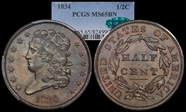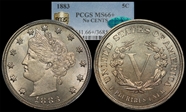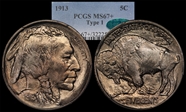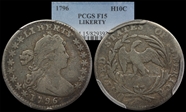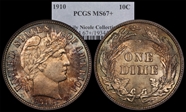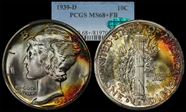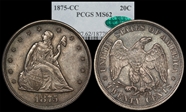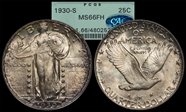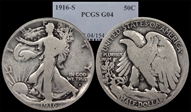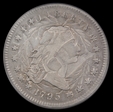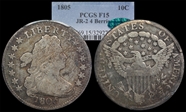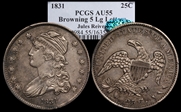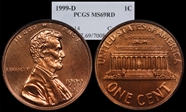orifdoc 的钱币相册
This coin has quite a bit of red showing in protected areas. Detail is outstanding and surfaces show no distracting marks on a nice, even planchet.
Half cents get no respect. This little coin has outstanding detail and a nice, even chocolate color. It also has outstanding luster in-hand. I love the width of the rim on these coins.
The classic head cent is a bit of a challenge when it comes to early copper. This example shows nice, smooth fields and excellent detail, especially for the assigned grade. A few rim nicks are evidence of its many years of service in everyday commerce.
Wonderfully detailed with full cartwheel luster. It's hard to believe this coin is almost 200 years old. I love the chocolate brown color with blue iridescence. Likely a coin from the Randall Hoard. N-13.
Large cents with great luster are really fun. This coin has an awful lot of red for a "BN" coin, especially over the reverse. Detail is incredible and there are no distracting marks. For type, it would be hard to do better.
Well-struck and exceptionally nice for grade. Some planchet striations are visible. Nice luster twirls around in-hand. From Rick Snow.
Some coins are tremendously enjoyable beyond what can be described by a numerical grade. This one looks like it was pulled from a fresh roll yesterday. Sharp strike, even, smooth coloration and no distracting carbon spots make it truly exceptional. From Dave Wnuck.
The zinc-coated steel cents are rather unique in the history of US coins. While they are subject to corrosion and spotting, some have survived in incredible condition. This example boasts clean surfaces, sharp detail, and swirling chrome-like luster. Die polish lines are evident in the fields - vertically oriented on the obverse with horizontal lines on the reverse.
Pre-82 Memorial Cents are the most familiar coins to a generation of circulation collectors.
This is an odd coin with what looks like two reverse designs to me. More lustrous than I'm able to capture in a photo. Lots of red for a coin made during the Civil War. From Mark Feld.
I love the "O" mint mark on this coin. This issue is the only 3-cent silver not minted in Philadelphia. This example sports really flashy luster and a golden center over a steel-blue background.
The three-cent nickel is a bit of an oddity and the series is somewhat unpopular with current collectors. While the reverse design is a bit uninspired, the obverse features one of the nicest depictions of Lady Liberty to grace our coinage. This example is stellar with sharp detail, deep luster, and clean surfaces.
For some reason I've always liked shield nickels with rays. This one has a touch of rim color and a nice overall patina. A few die polish lines are evident on the reverse fields and a few hits are scattered along the reverse rim. Overall, a nice coin.
The story of conniving individuals gold-plating these and passing them off as $5 coins is interesting and apparently quickly led to a design change. Fortunately, many of the first year of issue survived in good condition. This one has a nice, even look with booming luster and a sharp detail.
The buffalo nickel is an American classic, and arguably the most successful of the "Renaissance" coins in terms of public recognition and uniform appeal. This example is stellar, with sharp detail, beautiful color, and flashy luster.
I figured out what this coin cost me in dollars per gram and I shouldn't have. This little coin saw plenty of action back in its day but somehow survived without any significant blemishes except for a small rim hit at the 6 o'clock position. All small-eagle material is special, but only 10,230 of these were produced. Perhaps 500 survive in all grades. Detail is perhaps slightly weak for grade, but smooth surfaces and even toning add significant appeal.
The Capped Bust Half Dime is a somewhat esoteric but fun series. There are no great rarities and most of the coins produced are technically well-made. This coin is an example of the LM-13 variety with a nice die break extending across the upper obverse. Well-struck, with cascading luster that is worthy of gem consideration. Eye appeal is excellent with nice golden-brown peripheral toning that lightens toward the centers. From Gerry Fortin.
Well-struck, lustrous, and great eye appeal with blazing orange and rose surfaces. For a type coin, it's hard to do better.
Ex. Duckor. This little coin is just incredible with sharp detail and virtually perfect surfaces. Brilliant luster erupts through a nice golden patina. One one example has graded higher, a beautiful 68+ from the Simpson collection.
The talents of Mr. Weinman are masterfully displayed in this timeless renaissance design. This superb jewel sports blazing, penetrating luster that boasts vibrant splashes of color. One trivial hit on the fasces is all that keeps this coin apart from the finest known in the entire series.
The 20-cent piece is an odd coin, and didn't last long in commerce. This example from Nevada is a wonderful addition to a type set, and more interesting, in my opinion, than the ubiquitous 75-S. For the issue, strike is exceptional. There are no major distractions. Slightly muted luster and a couple of stray hits and minor blemishes account for the grade.
I once found an 1861 quarter in a junk silver lot. It was my introduction to Seated Liberty coins and and since then this particular issue has always fascinated me. I've been looking for a BU coin for several years. For a relatively common Civil War coin, nice ones are surprisingly hard to locate. This one is not terribly flashy, showy, or perfectly clean. However, it is solid in every attribute and I think it is perfect for the assigned grade.
This coin is just fun to examine. Detail is good with just a touch of softness on star 11, the upper-right of the shield (which is almost universal) and the eagle's left claw. Color is exceptional with shades of silver-green and pink. Luster really pushes this coin into the upper grades and cascades over the surfaces nicely. A few linear toning breaks could easily be mistaken for scratches, but there is no disturbance of metal or luster in these areas. The 16-D is a common coin in gem condition, but this example is a cut above.
What a wonderful, gorgeous, stunning coin! Eye appeal is off the charts. SLQ's simply do not come like this. The coin is hammered, insanely lustrous, and technically excellent. Some examples might be graded higher, but it would be virtually impossible to find one better. From Tom Bush.
A glowing salmon/cinnamon patina adds to the nearly flawless surfaces of this Washington. Other than a touch of softness of detail in the eagle's breast feathers there isn't much to complain about here. From Larry Shapiro.
The quarter is the nicest of the bicentennial designs in my opinion. This piece shows great detail, clean fields, and bright luster with chrome-like surfaces.
Wow! Eye appeal and originality are off the charts here. Luster is deep and glowing. So very few coins from this era look like this. From John Agre.
I decided to look for a common-date CBH for my type set and was going through lots at a Heritage Auction when this one popped up. The deep luster of this piece drew me in, and somehow I ended up with an early coin, full of character. O-103.
The Arrows and Rays one-year type coin is a beauty. These are ridiculously expensive in most MS grades so this example suits me nicely. Color is outstanding for a circulated piece. This one was probably stored in an album for years. There is a bit of strike weakness on stars 6 and 7, but little else to complain about. In-hand, quite a bit of mint luster remains.
A splendid example of a design that is getting tired. Luster and strike are quite nice and overwhelm the few miniscule hits.
Who says clad can't be pretty? This coin is something truly special. Gorgeous pastel colors pop beneath outstanding luster. Extensive reverse die polish adds character. From James Sego.
Coins like this one could get a person interested in collecting moderns. If only they all looked like this one.
A tremendous coin which came to me via Mark Feld after many stops along the way. It was sold to a B&M by an old man carrying it in his pocket with loose change. Strong obverse clashes add character. The overlay photo shows how these happened. Outstanding detail for grade. B-9 BB-13 Die State 2. I now have the old ANACS photocertificate that goes with the coin.
A tremendous coin which came to me via Mark Feld after many stops along the way. It was sold to a B&M by an old man carrying it in his pocket with loose change. Strong obverse clashes add character. The overlay photo shows how these happened. Outstanding detail for grade. B-9 BB-13 Die State 2. I now have the old ANACS photocertificate that goes with the coin.
The duration of the hunt for this coin set a new personal record. Small Eagle dollars aren't terribly difficult to locate, but good luck finding nice ones! The present example is nice for the grade and, apart from a small rim bump, is free of any distractions.
A nice early dollar with deep red-brown toning and no distracting marks. A small area of retained luster is seen on the eagle's right wing. From Mark Feld.
In general, I prefer the clean look of the no-motto dollars but this example is stunning. Like most coins of this era there is a good chance it was dipped, but if so, it has returned with outstanding color. Luster and eye appeal are quite nice for the assigned grade. From a Heritage auction via Mark Feld.
The trade dollar is a somewhat unique coin in US Numismatics. As opposed to almost every other Federal issue, it wasn't really intended to circulate here. This example sports really nice luster, nice detail, and just a few scattered marks above Liberty's right arm.
Well, this is a phenomenally beautiful coin. The person who sold it to me acquired it in a bullion deal. Bullion! Imagine.
A collection is defined by its key dates and this is especially true of the 1921, the only coin in the series true to de Francisci's original design. This example has stellar luster and is beautifully toned in shades of gold, green, and magenta. This coin surely sat for years in an album. A real American Beauty! Sadly, this is the last of our nation's coin designs to feature Liberty and the last true silver dollar. From a Heritage Auction with help from Mark Feld.
This is a fantastic Peace dollar, with original surfaces, nice frost, outstanding detail, and solid luster. A few scattered hits do not detract from the portrait or eagle.
I've owned a few nice 1926 Philadelphia coins but this one is is one of my favorites. The cheek is clean, there is plenty of luster, and deep frost is visible between the feathers. Detail is as good as they come and there are no distracting marks.
The unloved Ike is considered common by many, but high-grade examples are surprisingly elusive. Coins with outstanding character and color are even more challenging. This fantastic piece sports salmon-pink highlights over a background patina of golden olive hues.
1976 Mint State Ikes just don't come any nicer than this! From James Sego.
The little Type I gold dollar is the nation's smallest coin. At a whopping 13mm in diameter, this series would not be a good choice for the visually-impaired. This example sports really nice detail and luster. The obverse would command a gem designation but is held back by the slightly weaker reverse.
The type 2 gold dollar is an interesting but short-lived issue. I quite like the design, but almost all examples show central strike weakness. This example is a little better than average in this respect. It has has a nice, old patina and lively luster. Unlike many others, there are no clash marks. Some superficial, but not especially distracting stray marks account for the grade.
Gold dollars are either your thing or they aren't. I find them fascinating and little jewels like this one are miniature works of art, far exceeding their intended purpose of instrument of commerce. This type 3 example is a wonderfully original specimen from the final year of mintage. Luster is brilliant and cascading. Detail is excellent and the coin has a rich, orange coloration.
This piece has a nice crusty look consistent with its age. In-hand, it also demonstrates about 20 degrees of die rotation. From Gary Adkins.
Nice luster, solid strike, and clean surfaces combine to create a beautiful gem.
As a type coin, the Classic Half-Eagle isn't too difficult to locate, but specimens with plausibly original skin are another story. This example is really nice for the assigned grade. It will do nicely until a better example finds its way to me.
Sometimes D does not stand for Denver. This is one of those times. This little coin has really nice character and richness of color that is appropriate to its age and a bit of time in commerce. Southern gold has a unique charm. This coin shows perfectly forgivable weakness in strike but enough luster that it could easily be in a lower-AU holder. From Doug Winter. 32-V.
The Liberty Half Eagle is a coin that spans an incredible range of dates. This 20th Century example sports really nice surfaces and deep, rich luster. It looks as nice as the day it was made.
For me, it was a longtime goal to someday own an 18th Century Eagle. I started looking in 2016 and started seeing what I had been told - that most had been dipped and stripped. Those were nice enough, but lacked the soul that should accompany a 200+ year old coin. A handful of others were beautiful, but outside of my budget in MS grades. Finally, this one showed up and looked to be perfect. It's a BD-2, and is one of an estimated 35-45 extant coins from this die pair. Detail is amazingly sharp with full rims and dentils. Feather and hair detail is complete. A few very light adjustment marks are seen on the shield. Plenty of luster remains and it's quite lively in-hand. By today's standards it would probably grade higher, but it's just fine in the rattler holder. What a treat!
The 1901-S is the most common Liberty Eagle. Most likely, this example spent some time lounging around in Swiss bank vaults. The majority of the 200,000 or so extant examples are uncirculated, but most are in the range of MS62-MS64. They become more scarce at gem grades. This example has a rich, original patina, a touch of copper showing below the arrows in the left claw of the eagle, and really nice detail. Luster is deep and just a few light ticks keep it out of a 66 holder.
Liberty Double Eagles are impressive coins which represented an enormous store of value when produced. This common-date example demonstrates booming luster and no significant distractions. It's a true gem in every way.
Unique among classic commemoratives, the little Isabella is a nice design. After looking at many coins I became a little frustrated with this issue. There are plenty of them on the bourse floor at any big show but most lack either character or luster. This one was located by CRO and I was happy to give it a new home.
The depicted subject matter is worthy of a dollar coin and represents the longstanding friendship of two great nations. Having lived in France, this one is dear to my heart. This issue becomes rather expensive at gem grades so this humble coin will have to do. It shows plenty of character and eye appeal for the assigned grade.
The eagle on the reverse of the Alabama Commem is one of the best in US numismatics. The design is executed in excellent relief and unlike some commems is sharply detailed. This example has nice rim toning on both sides with unbroken luster.
The battle of Antietam was a horrific scene of American bloodshed and fully deserving of commemoration. This coin displays deep but appropriate toning that accentuates the devices. Luster is fantastic and unbroken.
Wow. This coin is spectacular with deep brassy centers and electric blue rims. Detail is stellar and flashy luster easily cascades around the coin.
The Connecticut Commem features two outstanding designs. The Art Deco Eagle is emblematic of its era and the tree is rendered with artistic flair. This example has a natural patina which accentuates sharp design details. Luster is flashy and cascading.
Well, this coin is truly special. We were lucky enough to visit Gettysburg on a trip to Pennsylvania a few years ago and the history of the place is moving. I've owned a couple of these coins, but this one is ridiculously under-graded. Color is off-the-charts insane and the coin is technically excellent. This one, I could stare at for hours.
Gimmicky made-for-collector items don't usually interest me all that much, but for some reason I have a particular like for the Grant w/star commemorative. This example is untoned (also a bit unusual for my taste) but it has lively luster and no distracting marks. Strike is a bit soft in Grant's hair, as is typical of the issue.
Many of the classic commems seem overly contrived or poorly executed. The Lincoln is a remarkable exception, sporting a solemn depiction of one of our most beloved leaders and one of the strongest eagles to be found anywhere on our coinage. This example is solid with phenomenal eye appeal and detail. Luster is all-there. The coin is just so darn fun to look at.
The Peace dollar is my favorite coin and de Francisci's other design is the beautiful Maine commem. This example sports elegant, original toning with a few splashes of color. Design details and luster are outstanding.
The concentric rings of text give this design a unique look and the overall layout is well-balanced. This example is partially obscured by scuffing on the inside of its rattler holder. Luster is fantastic and design detail is sharp. A bit of pleasing patina adds character.
The concept for the issue of this beautiful coin originated in Pocatello, Idaho, a few miles from where I grew up. This example was previously part of "The Bear Legacy Collection". I am honored to be its caretaker. The design is among the finest of all commemoratives.
The Pilgrim holds a special place in my heart. The designer, Cyrus Dallin, is my first cousin, four-times removed. A bit of controversy surrounded the design of the coin, as is seemingly true for most issues of the era but the subject matter is thoughtfully rendered in my biased opinion. This example is superb, with outrageous eye appeal, phenomenal detail, and flashy luster. A nice little die crack passes perfectly through Dallin's obverse "D". The assigned grade clearly represents old-school thinking as indicated by the OGH holder and gold CAC sticker.
The Vermont is a well-made commem with great relief and detail. While not as colorful as Vermont in the fall, this example sports a flashy obverse under a slight yellow-brown patina. The reverse features a rich golden color with hints of green. Our time living in Vermont produced a wealth of treasured memories.
Poor Susie. The mint really did a poor job on this one. The best part of the coin is the 13-sided pseudo-rim and the borrowed reverse from the Ike dollar. The dollar-that-looked-like-a-quarter was never popular and her head isn't nearly so Moby Dick as it was depicted here.
Early US type is always fantastic, even at relatively low grades. This coin shows the evidence of many travels and clearly served its intended purpose well. Crusty, toned, and without distracting marks is a perfect look for a 210 year-old coin.
Just a really nice original Bust quarter. Was NGC AU58. Ex. Jules Reiver.
Roughly one-half trillion Lincolns have been produced. Almost none have a level of detail and strike quality to compare with this one. Deep, flashy luster completes the effect. This little coin represents the pinnacle of the US Mint's 20th Century business-strike craftsmanship.
While not as beautiful as the Buffalo design, the Jefferson Nickel is the least objectionable of the modern "Politician" coins in my opinion. This example is superb, with deep luster and almost perfect design details. It's hard to believe the design is almost 80 years old.
The Roosevelt dime is not a terribly popular coin and the design seems to be stuck in perpetuity. This example demonstrates really incredible in-hand luster and color that photographs don't depict well. Photos also over-emphasize slight luster breaks on FDR's cheek.
This 1996 issue is the first and only US dime to feature a W mintmark. The 1996-W also has the lowest mintage within the Roosevelt series. This example is well-struck with nearly perfect surfaces.
Hmmm. This is a dangerous coin for me. I don't like Morgans..... right? Right?
The Pan-Pac is one of the old classics, the only silver issue in a set of 5 coins that typify the artistic merit of the time. This example sports wonderful detail, nice luster for the issue, and gorgeous rim toning. The repunched-mint mark is an uncommon but interesting variety.
A nice enough issue for the first president, even if his appearance is a little stern.
I'm not sure why, but a nice Reeded-Edge half has eluded me for many years. The vast majority of these are really lacking in eye appeal. This one is no gem, but it has nice surfaces and better-than-expected luster. I'm guessing that the toning is secondary to a remote dipm, but it has come back nicely. Interesting prominent strike weakness is seen around the 6 o'clock reverse and 12 o'clock obverse. This is undoubtedly the grade-limiting attribute of the coin.
The world of Liberty Cap Large Cents is a large and complex one. Varieties abound, and 1794 issues alone could give EAC folks enough material for a lifetime of enjoyment. This example exudes originality, a bit of crustiness, nice remaining detail, and plenty of circulation-appropriate battle scars. My only complaint here is that the reverse fraction is weak. The die breaks easily identify this as a B-33, S44.




















